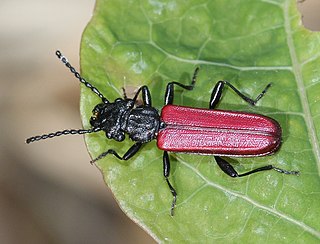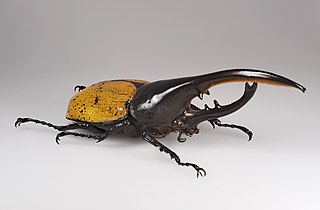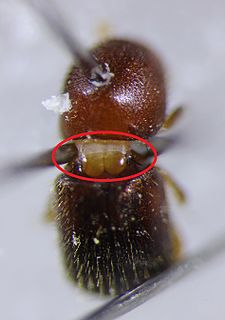
The telephone-pole beetle is a beetle native to the eastern United States, and the only living representative of the otherwise extinct family Micromalthidae.

Passalidae is a family of beetles known variously as "bessbugs", "bess beetles", "betsy beetles" or "horned passalus beetles". Nearly all of the 500-odd species are tropical; species found in North America are notable for their size, ranging from 20–43 mm, for having a single "horn" on the head, and for a form of social behavior unusual among beetles.

The Cucujidae, "flat bark beetles," are a family of distinctively flat beetles found worldwide under the bark of dead trees. The family has received considerable taxonomic attention in recent years and now consists of 59 species distributed in four genera.

The Hercules beetle is a species of rhinoceros beetle native to the rainforests of Central America, South America, and the Lesser Antilles. It is the longest extant species of beetle in the world, and is also one of the largest flying insects in the world.

The family Oedemeridae is a cosmopolitan group of beetles commonly known as false blister beetles, though some recent authors have coined the name pollen-feeding beetles. There are some 100 genera and 1,500 species in the family, mostly associated with rotting wood as larvae, though adults are quite common on flowers. The family was erected by Pierre André Latreille in 1810.

The term mycangium is used in biology for special structures on the body of an animal that are adapted for the transport of symbiotic fungi. This is seen in many xylophagous insects, which apparently derive much of their nutrition from the digestion of various fungi that are growing amidst the wood fibers. In some cases, as in ambrosia beetles, the fungi are the sole food, and the excavations in the wood are simply to make a suitable microenvironment for the fungus to grow. In other cases, wood tissue is the main food, and fungi weaken the defense response from the host plant.

Ptinidae is a family of beetles in the superfamily Bostrichoidea. There are at least 220 genera and 2,200 described species in Ptinidae worldwide. The family includes spider beetles and deathwatch beetles.

Jacobsoniidae is a family of beetles. The larvae and adults live under bark, in plant litter, fungi, bat guano and rotten wood. It is a small family with 23 described species in three genera:

Prionoceridae is a small family of beetles, in the suborder Polyphaga. The form a group within the cleroid beetles and were formerly treated as a subfamily Prionocerinae within the family Melyridae. Very little is known of their life history but most species are pollen feeders as adults and occur in large numbers during spring or the host flowering season. Larvae are predatory or feed on decomposing wood.

Silvanidae, "silvan flat bark beetles", is a family of beetles in the superfamily Cucujoidea, consisting of 58 described genera and about 500 described species. The family is represented on all continents except Antarctica, and is most diverse at both the generic and species levels in the Old World tropics.

The Trictenotomidae are a small family of beetles in the suborder Polyphaga containing fifteen species in two genera. Most species are found in the Oriental realm where they live in montane forest habitats. The family is considered, based on larval characters as well as sequence-based studies, to be closely related to the Salpingidae.
Phloeosinini is the tribe of bark beetles which includes the genera Carphotoreus, Catenophorus, Chramesus, Cladoctonus, Cortisinus, Dendrosinus, Hyledius, Hyleops, Paleosinus, Phloeocranus, Phloeoditica, Phloeosinopsioides, Phloeosinus, Protosinus and Pseudochramesus.

Jean-Pierre Lacroix (1938–1989) was a French entomologist.

The Eucnemidae, false click beetles, are a family of polyphagan beetles including about 1700 species distributed worldwide.

Ancyronyx, commonly known as spider water beetles or spider riffle beetles, is a genus of aquatic riffle beetles from North America, South Asia, China, and Southeast Asia. They are small beetles with extremely long legs ending in strong claws. Both the adults and the larvae are found underwater in the shallow riffles of streams and rivers, clinging to rocks or submerged wood. They feed on algae and decaying wood tissue. The genus contains twenty-one species, eleven of which are endemic to the Philippines.

Ips is a genus of beetles in the family Curculionidae, the true weevils. They are bark beetles, members of the subfamily Scolytinae. Species are distributed throughout the Northern Hemisphere. Some are known as introduced species in Australia and Africa. Many species are pests of forest trees, especially pines and spruces. They are known commonly as engraver beetles, ips engraver beetles, and pine engravers.
Acronymolpus is a genus of leaf beetles in the subfamily Eumolpinae. They are endemic to New Caledonia. There are two species placed in the genus, both of which are sexually dimorphic; the females are large and reddish, and the males are small and black.
Taophila is a genus of leaf beetles in the subfamily Eumolpinae. The genus is endemic to New Caledonia.
Xerolinus is a genus of darkling beetle. It consists of approximately thirty species found in the West Indies. Michael A. Ivie and Charles J. Hart named and circumscribed the genus in 2016.

Bromiini is a tribe of leaf beetles in the subfamily Eumolpinae. The tribe contains approximately 120 genera, which are found worldwide. They are generally thought to be an artificial group, often with a subcylindrical prothorax without lateral ridges and covered with setae or scales.
















